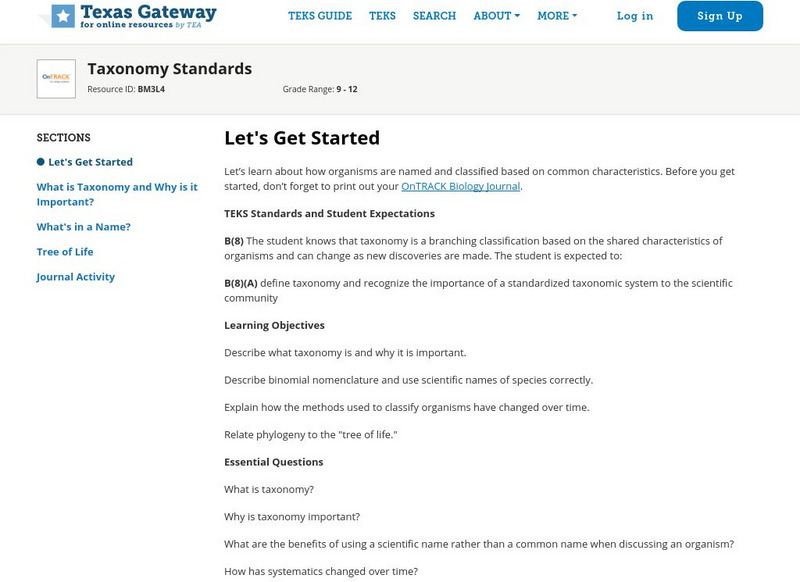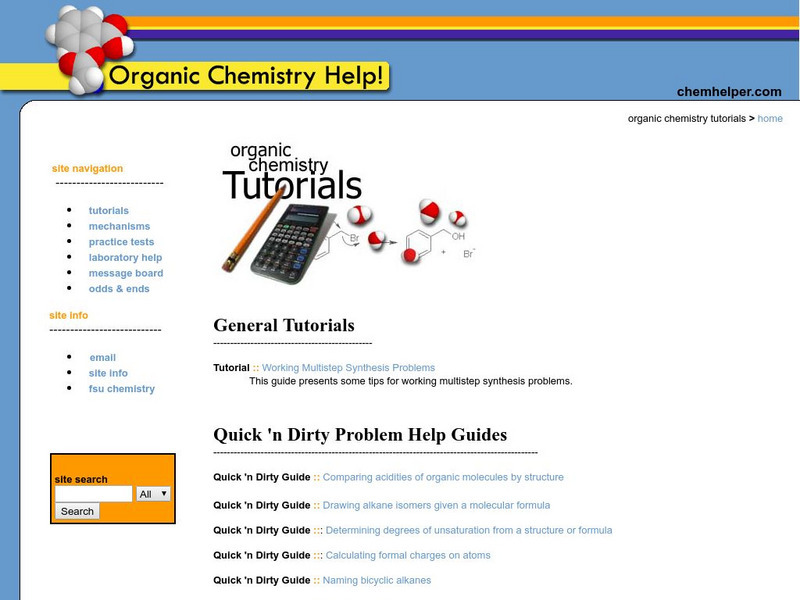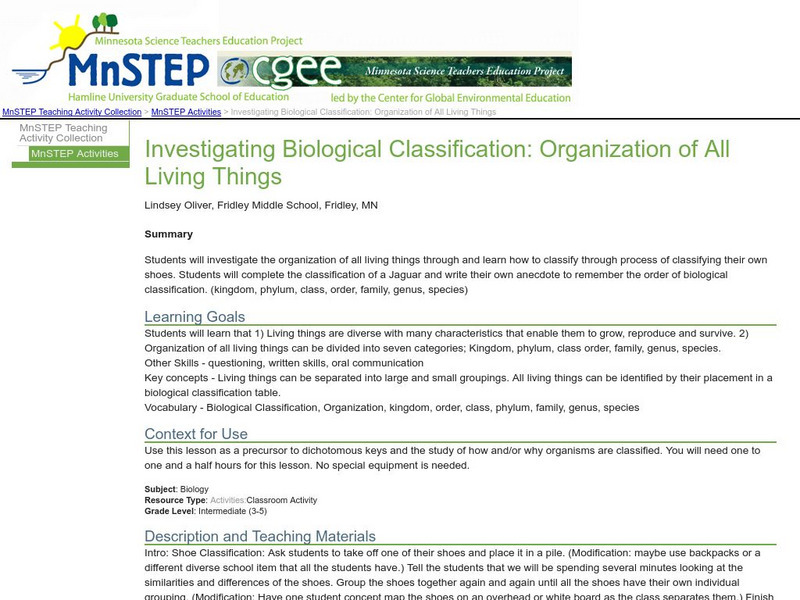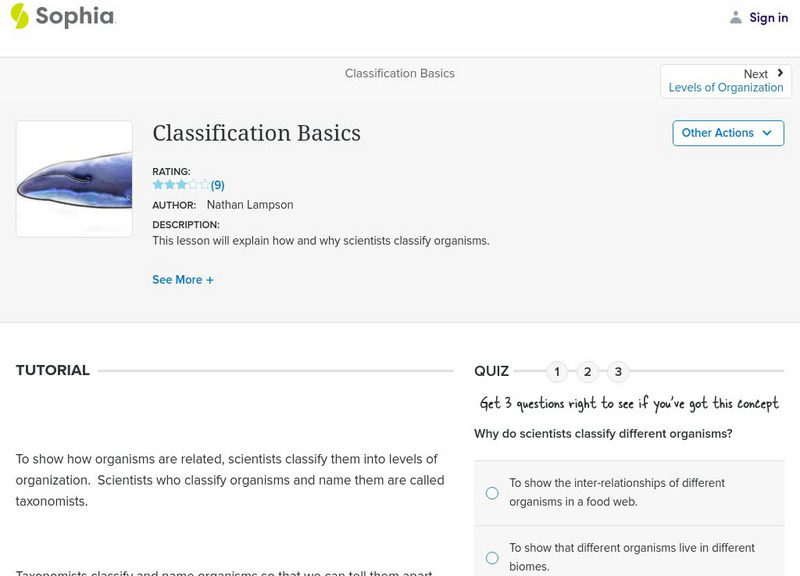Georgia Department of Education
Ga Virtual Learning: Biology: Taxonomy
In this multi-media module students derive the relationship between single-celled and multi-celled organisms and the increasing complexity of systems.
Texas Education Agency
Texas Gateway: Taxonomy Standards
What's in a name? Learn about how organisms are named and organized in this interactive tutorial.
Other
Frostburg State University: Organic Chemistry Tutorials
This site features tutorials on alkenes, alkanes, alkynes, alcohols, carboxylic acids, amines, ketones, aldehydes, and benzene. The tutorials lists the properties of each, structure and classification, the nomenclature, and gives...
Texas Education Agency
Texas Gateway: Taxonomy: Major Groups
Do you know that organisms are classified into different categories? This tutorial will show you how organisms are classified into three different groups called domains. Then see how those domains are broken down into kingdoms!
CK-12 Foundation
Ck 12: Life Science: Organization of Living Things
[Free Registration/Login may be required to access all resource tools.] When you see an organism that you have never seen before, you probably put it into a group without even thinking. If it is green and leafy, you probably call it a...
Soft Schools
Soft Schools: Classification Quiz
Take this interactive, multiple-choice quiz over classification of organisms, then review your score and any missed questions at the end.
Science Education Resource Center at Carleton College
Serc: Investigating Biological Classification: Organization of All Living Things
All living things can be identified by their placement in a biological classification table. Learners will investigate the organization of all living things and learn how to classify through the process of classifying their own shoes....
Soft Schools
Soft Schools: Classification of Organisms Quiz
Take an interactive quiz over the classification of living things. After completing the quiz, check your score, and then revisit any incorrect question for further review.
McGraw Hill
Glencoe Biology: Modern Classification: Self Check Quiz
Try these five self-checking quiz questions over modern classification of living things. Click on the hints to see information about each question.
Sophia Learning
Sophia: Classification Basics
This lesson will explain how and why scientists classify organisms.
CPALMS
Florida State University Cpalms: Florida Students: Diagramming Diversity I
Identify how living organisms are classified according to their evolutionary history. Recognize how a hierarchical classification scheme can be used to classify living organisms based on physical characteristics.
Sophia Learning
Sophia: Classification of Organisms: Lesson 1
This lesson will introduce taxonomy and give an example by providing the scientific classification of an organism. It is 1 of 2 in the series titled "Classification of Organisms."
Sophia Learning
Sophia: Classification and Division Papers: Organization
This lesson discusses structuring an outline for a classification paper.
Alabama Learning Exchange
Alex: Learn the Library of Congress Classification System
The learners will develop an understanding of the organization of main and primary subclasses of the Library of Congress Classification System. The students will demonstrate knowledge and independence in using the LCC through online...
Austin Independent School District
Austin Independent School District: A Taxonomy of Literary Genre [Pdf]
A series of graphic organizers shows the progression of learning about literary genre, beginning in kindergarten and building through to fifth grade.
Discovery Education
Discovery Education: Animal Classification
Use this lesson to help students understand the reasons for classifications and ways that different species are separated.
Tree of Life Project
The Tree of Life Web Project
The Tree of Life is a multi-authored, Internet distributed project containing information about phylogeny and biodiversity. The Tree of Life can be used to locate information about a particular group of organisms through their taxonomy.
PBS
Pbs: Mathline Creature Feature Lesson Plan [Pdf]
An interdisciplinary math, science, and language arts lesson plan that engages students in an exploration of statistics. Through a study of various forest climates, students utilize data collection and analysis, classification, and...
Other
Math and Science Activity Center: Classification of Living Things
Kingdom is the highest rank used in the biological taxonomy of all organisms. There are 6 kingdoms in taxonomy. Every living thing comes under one of these 6 kingdoms. The six kingdoms are Eubacteria, Archae, Protista, Fungi, Plantae,...
ClassFlow
Class Flow: Animal Classification
[Free Registration/Login Required] Students will classify organisms into groups and relate how they determined the groups with how and why scientists use classification. They will also demonstrate how animals are sorted into groups...
University of British Columbia
University of British Columbia: Soil Components
Use this interactive website to learn everything you wanted to know about the four components of soil: minerals, organic, water, and air. Many links along the way assist with comprehension by allowing you to view photographs, charts, and...
Cornell Lab of Ornithology
Cornell Lab of Ornithology: All About Birds
One of the great attractions of this site is the ability to listen to the birds. Each bird is categorized with a picture, description, its cry, conservation status and "Cool Facts." There are tips for attracting birds as well as...
Georgia Department of Education
Ga Virtual Learning: Ap Biology: Animals
This unit focuses on the unique structure and function of both invertebrate and vertebrate animals. Students review their understanding of animal diversity, and take a closer look at the various organ systems found in the animal kingdom.
CK-12 Foundation
Ck 12: Episd: Animal Characteristics
[Free Registration/Login may be required to access all resource tools.] Students will be able to identify and classify organisms that are animals based on recognition of traits presented.














![Austin Independent School District: A Taxonomy of Literary Genre [Pdf] Graphic Austin Independent School District: A Taxonomy of Literary Genre [Pdf] Graphic](https://d15y2dacu3jp90.cloudfront.net/images/attachment_defaults/resource/large/FPO-knovation.png)





